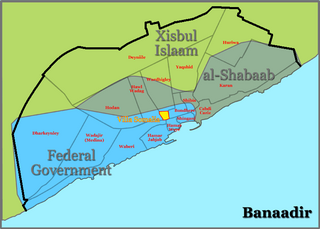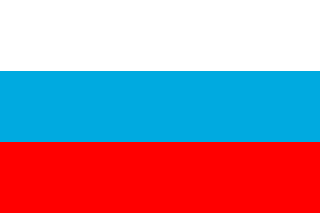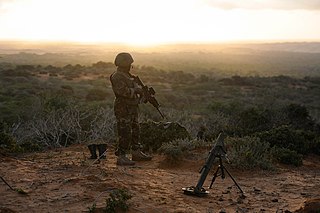
Kismayo is a port city in the southern Lower Juba province of Somalia. It is the commercial capital of the autonomous Jubaland region.

The Somali Civil War is an ongoing civil war that is taking place in Somalia. It grew out of resistance to the military junta which was led by Siad Barre during the 1980s. From 1988 to 1990, the Somali Armed Forces began engaging in combat against various armed rebel groups, including the Somali Salvation Democratic Front in the northeast, the Somali National Movement in the northwest, and the United Somali Congress in the south. The clan-based armed opposition groups overthrew the Barre government in 1991.

The African Union Mission in Somalia (AMISOM) was a regional peacekeeping mission operated by the African Union with the approval of the United Nations Security Council. It was mandated to support transitional governmental structures, implement a national security plan, train the Somali security forces, and to assist in creating a secure environment for the delivery of humanitarian aid. As part of its duties, AMISOM supported the Federal Government of Somalia's forces in their battle against Al-Shabaab militants.
The fall of Kismayo occurred on January 1, 2007, when the troops of Somalia's Transitional Federal Government (TFG) and Ethiopian forces entered the Somali city of Kismayo unopposed. It came after the Islamic Courts Union's forces faltered and fled in the Battle of Jilib, abandoning their final stronghold.
The Battle of Kismayo began on August 20, 2008 when Ogaden clan fighters took the battle to Ethiopian forces in Kismayo and their protectorate clan, the Marehan clan. Fighters began an offensive to conquer the Southern Somali port of Kismayo from pro-government militias. Three days of fighting reportedly killed 89 people and injured 207 more. The Ogaden clan led by Ahmed Madoobe took the town, at the expense of the Marehan clan who were up to that point kept in the city by the Ethiopian army. After the retreat of the Ethiopian army, the Marehan militia led by Barre Hiiraale were seen fleeing the city in all directions before eventually succumbing to Ras Kaambooni on August 22.

The Somali civil war (2009–present) is the ongoing phase of the Somali civil war which is concentrated in southern and central Somalia. It began in late January 2009 with the present conflict mainly between the forces of the Federal Government of Somalia assisted by African Union peacekeeping troops and al-Qaeda-aligned al-Shabaab militants.

Ahmed Abdi Godane, also known as Mukhtar Abu Zubair, was the Emir (leader) of Al-Shabaab, an Islamist group based in Somalia. Godane, who received training and fought in Afghanistan, was designated by the United States as a terrorist. The exact date of Godane's rise to al-Shabaab's Emir is debated, although it seems he ascended to this position in December 2007.

The Battle of Mogadishu (2010–11) began on 23 August 2010 when al-Shabaab insurgents began attacking government and African Union Mission to Somalia (AMISOM) positions in the Somali capital of Mogadishu. Al-Shabaab began its offensive after its spokesman said the group was declaring a "massive war" on troops sent by AMISOM, describing its 6,000 peacekeepers as "invaders". In December 2010 the number of AMISOM troops was increased to 8,000 and later to 9,000. The battle's name usually includes the years, when referenced, in order to distinguish it amongst the nine major Battles of Mogadishu during the decades long Somali Civil War.

This is a 2011 timeline of events in the Somali Civil War (2009–present).

The Raskamboni Movement was a jihadist Islamic movement led by Sheikh Ahmed Madobe, the current president of the Jubaland state in southern Somalia. After fighting with Al-Shabaab they managed to capture Kismayo with the help of Kenya.

Azania, officially the Republic of Azania, was a self-proclaimed autonomous state of Jubaland in southern Somalia that existed from 2011 to 2013. A group of Somali politicians proclaimed the creation of Azania on 3 April 2011 in Nairobi, with Mohamed Abdi Mohamed as its President. The state's main intentions were to contest al-Shabaab, which largely controlled Jubaland.

Operation Linda Nchi had the Kenya Defence Forces enter southern Somalia beginning in 2011. The Kenyan government declared the operation completed in March 2012, but its forces then joined AMISOM in Somalia.

This is a 2012 timeline of events in the Somali Civil War (2009–present).

This is a 2014 timeline of events in the Somali Civil War (2009–present).

Operation Indian Ocean was a joint military operation between the Somali military, AMISOM and the United States military against the Al-Shabaab militant group aimed at eliminating the remaining insurgent-held areas in southern Somalia. It officially began in August 2014.

This is a 2015 timeline of events in the Somali Civil War (2009–present).
This article contains a timeline of events for the Somali jihadist group al-Shabaab.

The Battle of El Adde took place on 15 January 2016. Al-Shabaab militants launched an attack on a Kenyan-run AMISOM army base in the town of El Adde, Gedo, Somalia. It remains the deadliest attack on the African Union Mission to Somalia and is the Kenya Defence Forces (KDF) largest defeat since independence in 1963. As such, the Kenyan government went to extreme lengths to conceal the extent of its losses. It has been described by the media as a "military massacre" or military disaster. It was also the largest military defeat in Kenyan history.
The Golweyn ambush by al-Shabaab militants against an AMISOM convoy took place on 30 July 2017. Resulting in the death of several Ugandan soldiers, the attack seriously disrupted the control of pro-government forces over the Lower Shebelle region in Somalia, eventually leading to the fall of the strategically significant town of Leego to al-Shabaab.

This is a 2016 timeline of events in the Somali Civil War (2009–present).














